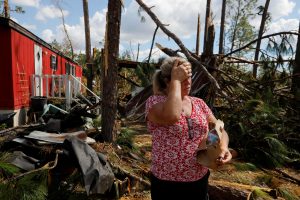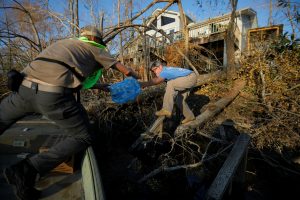
By Brian Snyder
FOUNTAIN, Fla. (Reuters) – After a fitful night of throbbing abdominal pain, curled up in a ball inside her hurricane-battered home trying to wish away the agony, 21-year-old Angelena Sawyer could barely function, let alone tend to her infant daughter.
Writhing in misery, Sawyer had no idea she was suffering from acute appendicitis. Neither did her parents nor her husband, Jacob Sibilia, fully realize the gravity of the situation as they coped with the larger crisis of surviving the aftermath of a natural disaster.
A week already had passed since Hurricane Michael laid waste to rural Bay County, Florida, leaving Sawyer’s family, like many others, essentially stranded without electricity, phone service or running water. They had little if any gasoline, a 3-month-old to care for, and Sawyer’s stepmother, Jessica Melvin, was suffering from an infected foot injury.

Hurricane Michael survivor Yvette Beasley stands in her front yard during a wellbeing check by a 50 Star Search and Rescue team in Fountain, Florida, U.S., October 17, 2018. REUTERS/Brian Snyder
The turning point was a random visit that day by three disaster volunteers – Zach Smith, John Basehore and Robert Pepper – checking on residents door to door in the sparsely populated Florida Panhandle community of Fountain, northeast of Panama City.
Assessing Sawyer’s condition, they realized she needed immediate medical attention. While Smith cleaned and bandaged Melvin’s foot, his colleagues called the local fire department and arranged for an ambulance to transport Sawyer to the nearest hospital some 30 miles away.
Doctors who treated her later told Sawyer her appendix had nearly ruptured. The intervention of Smith, Basehore and Pepper had likely saved her life.
At least 29 deaths in Florida have been attributed to Michael, which slammed ashore on Oct. 10 as a Category 4 hurricane and the most powerful on record ever to hit the Panhandle region.

50 Star Search and Rescue team member Robert Pepper (L) delivers water to Hurricane Michael survivor Denny Chevillot along the Chipola River in Florida, U.S., October 18, 2018. REUTERS/Brian Snyder
“If it wasn’t for this crew and these men, I wouldn’t have made it to the hospital,” Sawyer told Reuters in a text message following her ordeal.
The three men, all U.S. military veterans, were part of the volunteer group 50 Star Search and Rescue, one of dozens of such outfits formed during previous flood disasters in Texas and Louisiana and reactivated in Florida when Michael struck.
Many, including 50 Star, operated under the banner of CrowdSource Rescue, a larger Houston-based network that coordinated and supported teams on the ground with thousands of volunteers working remotely around the country.
Specialized technology was a key to their work.
Their search teams relied on a digital application that enables cell phones to operate as walkie-talkie radios, as well as an Uber-like app with global positioning satellite (GPS) map to pinpoint those in distress.
Much of their effort was devoted to searching for people whom loved ones reported missing in the hardest hit shorefront communities of Mexico Beach, Panama City, and Panama City Beach. Teams also fanned out to isolated areas farther inland to deliver meals, water and medical assistance.

The Lama family hold hot meals prepared by Operation BBQ Relief and delivered by a 50 Star Search and Rescue team following Hurricane Michael in Fountain, Florida, U.S., October 17, 2018. REUTERS/Brian Snyder
Their mission, said Smith, 30, was to “make sure that medically everyone is safe and sound and that people have supplies and that there’s no medical emergencies.”
After 11 days, CrowdSource teams succeeded in locating more than 2,800 people initially unaccounted for – all found alive – and turned over about 30 unresolved cases to local authorities, the group’s co-founder, Matthew Marchetti, told Reuters. The groups served some 4,500 meals to survivors during the past weekend alone, he said.
While reinforcing the strained resources of official search-and-rescue teams, the volunteers worked largely independently of them, Marchetti said.
Valerie Sale, a Bay County emergency management spokeswoman, said an almost total lack of cell phone and internet service that lasted nearly a week prevented coordination with outside volunteers, but “we’re grateful for their efforts, for sure.”
(Reporting by Brian Snyder in Fountain, Florida; Writing and additional reporting by Steve Gorman in Los Angeles; editing by Diane Craft)
